 |
|
Eielson Air Force Base Airport |
| Eielson Air Force Base
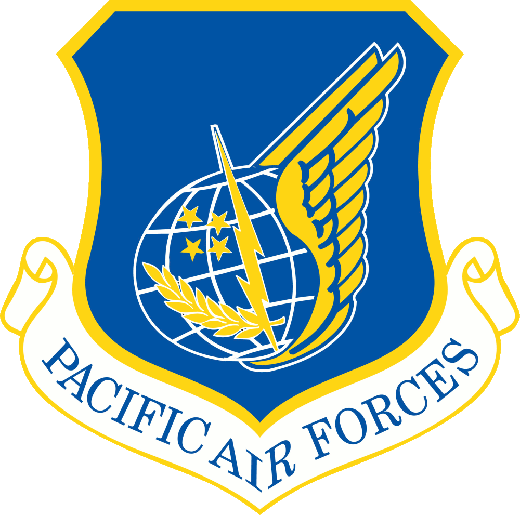
Pacific Air Forces
|
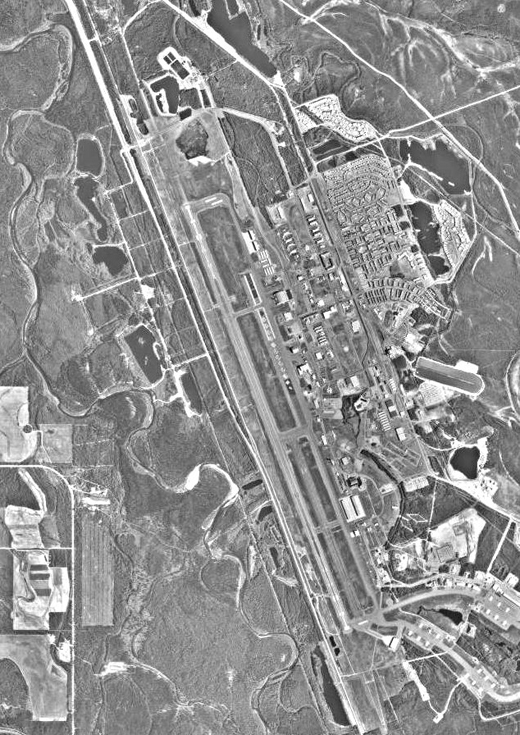 |
| USGS aerial photo as of 6 June 1999 |
| IATA: EIL – ICAO: PAEI – FAA LID: EIL |
| Summary |
| Airport type |
Military: Air Force Base |
| Owner |
United States Air Force |
| Operator |
Pacific Air Forces |
| Location |
Fairbanks North Star Borough near Moose Creek, Alaska |
| Built |
Aug. 1943 - October 1944 |
| In use |
1944 - present |
| Occupants |
354th Fighter Wing |
| Elevation AMSL |
547 ft / 167 m |
| Coordinates |
64°39′56″N 147°06′05″W / 64.66556°N 147.10139°W / 64.66556; -147.10139 |
| Website |
www.eielson.af.mil |
| Runways |
| Direction |
Length |
Surface |
| ft |
m |
| 13/31 |
14,530 |
4,429 |
Concrete |
| Source: FAA, official site |
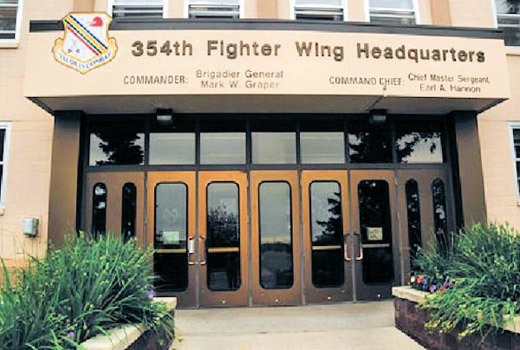 | |
354th FW Headquarters building |
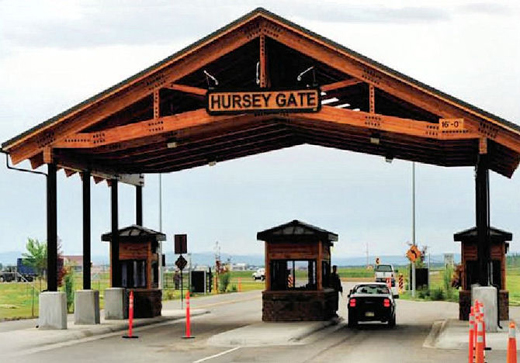 | |
Hursey Gate at Eielson |
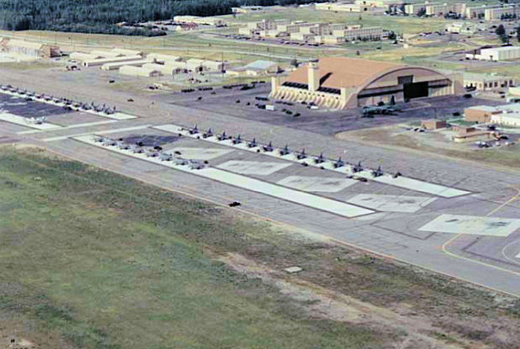 | |
Eielson Flightline |
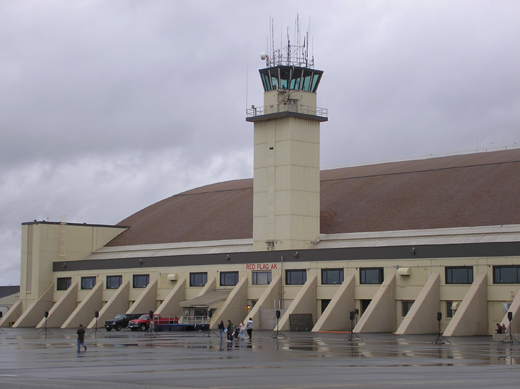 | |
One of two control towers at Eielson Air Force Base. Behind the tower is an aircraft hangar. |
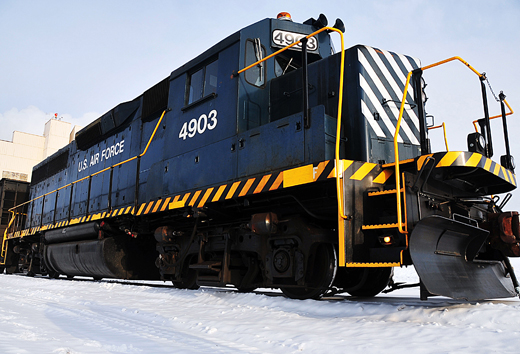 | |
A U.S. Air Force EMD GP40-2 locomotive sits outside Eielson AFB's central heat and power plant. The base owns two of these engines, both moving coal & rail traffic across the 11 mi (18 km) rail system, making it the second largest railroad in Alaska. |
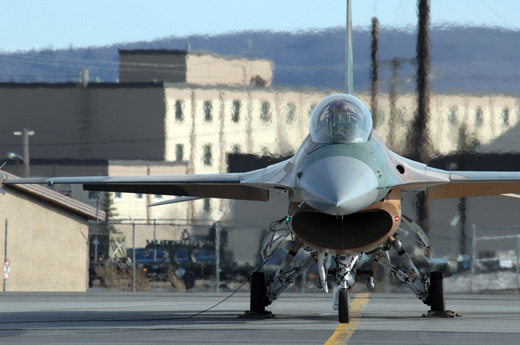 | |
An F-16 Fighting Falcon aircraft from Nellis Air Force Base's 64th Aggressor Squadron prepares to take off from Eielson Air Force Base. |
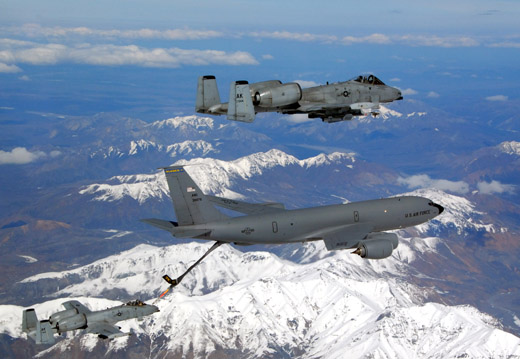 | |
An A-10 Thunderbolt II is refueled mid-air by a KC-135 Stratotanker from the Alaska Air National Guard's 168th Air Refueling Wing. |
Eielson Air Force Base (AFB) (IATA: EIL, ICAO: PAEI, FAA LID: EIL) is a United States Air Force base located approximately 26 miles (42 km) southeast of Fairbanks, Alaska and just southeast of Moose Creek, Alaska.
The host unit at Eielson is the 354th Fighter Wing (354 FW) assigned to the Pacific Air Forces Eleventh Air Force. The 354 FW primary mission is to support Red Flag-Alaska, a series of Pacific Air Forces commander-directed field training exercises for U.S. Forces, provides joint offensive counter-air, interdiction, close-air support, and large force employment training in a simulated combat environment.
Eielson AFB was established in 1943 as Mile 26 Satellite Field. It is named in honor of polar pilot Carl Ben Eielson. The 354 FW is commanded by General James N. Post III. Overview
Until 2007, Eielson was a front line base, deploying fighter and bomber units around the world as well as providing for the defense of Alaska.
Taken off deployment status in 2007 as a result of BRAC 2005, today the primary mission of the base is to support Red Flag-Alaska, a series of Pacific Air Forces commander-directed field training exercises for U.S. Forces, provides joint offensive counter-air, interdiction, close-air support, and large force employment training in a simulated combat environment. These exercises are conducted on the Joint Pacific Alaskan Range complex with air operations flown out of the two bases. Alaska's size enables the military to have the largest air-ground training complex in America.
Units
Eielson is home to the 354th Fighter Wing which is part of the Eleventh Air Force (11 AF) of Pacific Air Forces (PACAF).
The 354th Fighter Wing mission is "To train, deliver, maintain and support combat power across the globe while taking care of our people, their families and our infrastructure." To accomplish that mission, the wing implements flying operations, mission support, maintenance and medical care functions and is host to 10 tenant units.
- 354th Operations Group (Tail Code: AK)
- 354th Operations Support Squadron
- 18th Aggressor Squadron (F-16)
- 3d Air Support Operations Squadron
- 353d Combat Training Squadron
- 354th Maintenance Group
- 354th Maintenance Squadron
- 354th Aircraft Maintenance Squadron
- 354th Maintenance Operations Squadron
- 354th Mission Support Group
- 354th Civil Engineer Squadron
- 354th Contracting Squadron
- 354th Communications Squadron
- 354th Logistics Readiness Squadron
- 354th Force Support Squadron
- 354th Security Forces Squadron
- Tenant Units
- 168th Air Refueling Wing, Alaska Air National Guard (KC-135 Stratotanker)
- Det. 460, Air Force Technical Applications Center
- Arctic Survival School, Det. 1, 66th Training Squadron
- Det. 632, Air Force Office of Special Investigations
- Det. 1, 210th Rescue Squadron
History
Previous names
- Established as Mile 26 Satellite Field about 15 December 1943
- Mile 26 Field, 1 October 1947
- Eielson Air Force Base, 13 January 1948–present
Major Commands
- Army Air Forces Transport Command (June 1943 - November 1945)
- Eleventh Air Force, (November - December 1945)
- Alaskan Air Command, (December 1945 - August 1990)
- Pacific Air Forces, (August 1990–present)
Base operating units
- Stn #4, Alaskan Wg (AAFTC) (September 1943 - August 1944)
- 1466th Army Air Force Base Unit (August 1944 - January 1945)
- Satellite Fld 1466-1 Army Air Force Base Unit (January - June 1945)
- HQ and Base Service Sq, 519th Air Service Group (November - December 1947)
- 97th Airdrome Group (December 1947 - April 1948)
- Eielson AFB Wing (Base Complement) (April - September 1948)
- Eielson Bomb Wing (September 1948 - June 1949)
- 5010th Composite Wing (June 1949 - January 1951)
- 5010th Air Base Group (January 1951 - February 1953)
- 5010th Composite Wing (February 1953 - October 1954)
- 5010th Air Base Wing (October 1954 - January 1965)
- 5010th Combat Support Gp (January 1965 - October 1981)
- 343d Tactical Fighter Wing (October 1981 - July 1991)
- 343d Wing (July 1991 - August 1993)
- 354th Fighter Wing (August 1993–present)
Major USAAF/USAF units assigned
- 57th Fighter Group (September 1946 - April 1953)
- 97th Bombardment Wing (December 1947 - March 1948)
- 5010th Air Base Wing (April 1948 - October 1981)
- 4157th Strategic Wing (July 1960 - March 1967)
- 6th Strategic Wing (March 1967 - June 1992)
- 343d Tactical Fighter Wing (October 1981 - August 1993)
- 354th Fighter Wing (August 1993–present)
Aircraft Assigned
- A-10 Thunderbolt II (Now Decommisioned from Alaska)
- 18th Fighter Squadron (1981–91)
- 11th Tactical Air Support Squadron (1991–94)
- 355th Fighter Squadron (1994–2007)
- B-29/RB-29/WB-29
- 375th Recon Squadron (1949–51)
- 58th Weather Recon Squadron (1951–56)
- WB-47
- 55th Weather Recon Squadron Det 1 (1960–68)
- WB-50
- 58th Weather Recon Squadron (1955–58)
- VC/SC/C-47
- 375th Recon Squadron (1949–51)
- 5010th Combat Support Group (1952–59, 1962–69)
- C-123 Provider
- 5010th Combat Support Group (1965–66, 1969–71)
- F-4 Phantom II
- F-16 Fighting Falcon
- 18th Fighter Squadron (1991–2007)
- 18th Aggressor Squadron (2007–present)
- F-80
- 65th Fighter Squadron (1950–51)
- F-86 Sabre
- 720th Fighter-Bomber Squadron (1954–55)
- 455th Fighter-Bomber Squadron (1955)
- F-102 Delta Dagger
- 317th Fighter-Interceptor Squadron Det 3 (1960–69)
- F-106 Delta Dart
- 317th Fighter-Interceptor Squadron Det 3 (1965–69)
- HH-3
- 71st Aerospace Rescue and Recovery Squadron Det 1 (1970–80)
- CH/SH/HH-21
- 71st Aerospace Rescue and Recovery Squadron (1976–80)
- 5010th Combat Support Group (1960–69)
- 5040th Helicopter Squadron Det 1 (1969–76)
- KC-97 Stratotanker
- 40th Air Refueling Squadron (1959–61)
- KC-135 Stratotanker
- 6th Strategic Wing (1967–92)
- 168th Air Refueling Wing AKANG (1986–present)
- 415th Strategic Wing (1962–67)
- L-20
- 5010th Combat Support Group (1952–60)
- O-2A
- 25th Tactical Air Support Squadron (1971–89)
- OA-10
- 11th Tactical Air Support Squadron (1991–93)
- 355th Fighter Squadron (1993–present)
- OV-10 Bronco
- 25th Tactical Air Support Squadron (1986–89)
- P-51 Mustang
- 65th Fighter Squadron (1946–47)
- RC-135
- 6th Strategic Wing (1967–92)
- 4157th Strategic Wing (1962–67)
- T-33 Shooting Star
- 65th Fighter Squadron (1950–51)
- 5010th Combat Support Group (1957–81)
- 720th Fighter-Bomber Squadron (1954–55)
Operational history
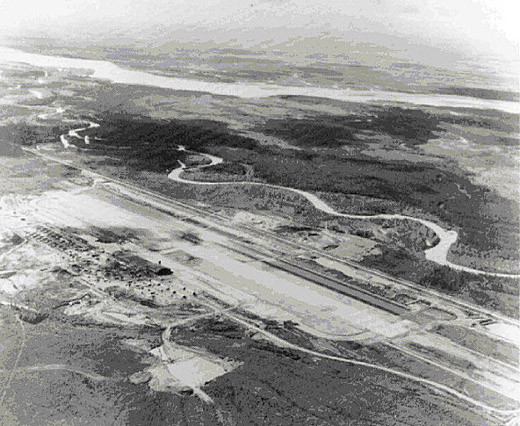 | |
26 Mile Field - now Eielson AFB - 1945 |
World War II
On June 7, 1943, the Western Defense Command ordered construction of a new airfield near present-day Fort Wainwright, then an Army airfield named after Major Arthur Ladd. Because of its hazard-free approaches and relatively flat terrain, surveyor reports indicated a site a little more than twenty five miles southeast of Ladd Army Airfield to be the best in the vicinity for military aviation. The field became known as “Mile 26” because of its proximity to a US Army Signal Corps telegraph station and a Richardson Highway milepost marker using the same designation.
A month later, contractors and civilian crews from Ladd Field started laying out the new airfield. Actual construction began on August 25, 1943. Crews built two parallel runways, 165 feet (50 m) across and 6,625 feet (2,019 m) long. Other facilities included an operations building, housing for 108 officer and 330 enlisted personnel, and a ten-bed dispensary. The garrison and airfield totaled about 600 acres (2.4 km). Completed on October 17, 1944, the 14-month project cost about eight million dollars.
Operational uses of Mile 26 were few. Ladd Field served as the debarkation point for the Alaska-Siberia Ferry Route of the lend-lease program and was the hub of activity. Lend-lease aircraft would occasionally land at Mile 26, but there are no records to indicate any lend-lease aircraft ever used the airfield to take off for Russia. Mile 26 closed when the war ended.
Cold War
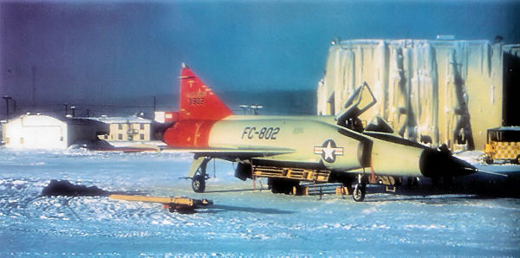 | |
Convair F-102A-15-CO Delta Dagger Serial 53-1802 undergoing cold weather testing. |
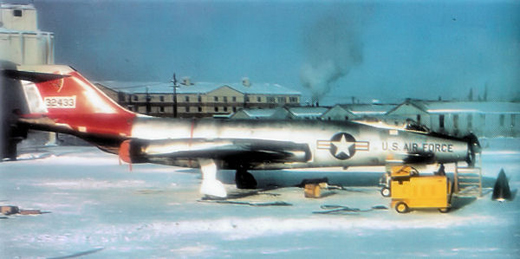 | |
McDonnell F-101A-10-MC Voodoo Serial 53-2433 undergoing cold weather testing. |
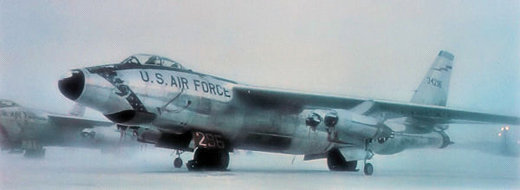 | |
Boeing RB-47H-1-BW Stratojet Serial 53-2496 on the snowy Eielson flightline. |
The base reopened in September 1946, once again as a satellite of Ladd Field. The first USAAF operational unit assigned to Eielson was the 57th Fighter Group, equipped successively with P-38 Lightnings, P/F-51 Mustangs, F-80 Shooting Stars, and F-94 Starfire aircraft. The 47th FG was inactivated on 13 April 1953.
On 1 December 1947 Strategic Air Command B-29 Superfortress bombers arrived at 26-Mile Airfield with the deployment of the 97th Bombardment Wing, Very Heavy, from Smoky Hill AFB, Kansas. The wing reported to Fifteenth Air Force, Strategic Air Command (SAC), although the Yukon Sector of the Alaskan Air Command controlled its operations. At the end of the Alaskan deployment the wing returned to Kansas on 12 March 1948.
A year later, however, Eielson moved from under the shadow of Ladd Field when the Alaskan Air Command assumed organizational control. Also in the fall of 1947, Colonel Jerome B. McCauley assumed duties as commander. The primary missions of Mile 26 were to support Arctic training for USAF tactical and strategic units, as well as defend the base itself.
Headquarters USAF General Order 2, dated January 13, 1948, redesignated Mile 26 as Eielson AFB. It was named for Carl Ben Eielson, an Alaska aviation pioneer who was killed, along with his mechanic Earl Borland, in the crash of their Hamilton aircraft in 1929. Eielson and Borland were attempting a rescue flight to an icebound ship in the Bering Sea when they were killed. On April 1, 1948, the Eielson AFB Wing (Base Complement) was formed. The host-unit subsequently would be dubbed the Eielson AFB Bomb Wing, and finally, in January 1949, the 5010th Wing. Colonel John L. Nedwed, the third commander of the base since it fell under Alaskan Air Command fifteen months before, became the first to head the 5010th.
For the next 34 years, the 5010th (alternately known as the Wing, Composite Wing, Air Base Wing, and lastly, Combat Support Group) served as host-unit at Eielson. Construction boomed at Eielson AFB during the 1950s. Many of the facilities still in use today were built at that time, including Amber Hall, the Thunderdome, Base Exchange, Gymnasium, Theater, some of the schools, and many of the dormitories.
The 720th Fighter-Bomber Squadron, equipped with F-86 Sabres, was deployed to Eielson during 1954-55. The 720th was a part of the 450th Fighter-Bomber Wing stationed at Foster AFB, Texas. The 720th was replaced by the 455th Fighter-Bomber Squadron (323d FBW), stationed at Bunker Hill AFB, Indiana.
The Air Defense Command deployed interceptors to Eielson during the 1960s. Det. 3, 317th Fighter-Interceptor Squadron from Elmendorf AFB Alaska deployed F-102 Delta Daggers and F-106 Delta Darts to the base between 1960-69.
375th/58th Strategic Weather SquadronThe 375th Weather Reconnaissance Squadron, from the 308th Bombardment Group at Tinker AFB Oklahoma, arrived at Eielson on 5 March 1949. The 308th flew WB-29 Superfortresses. The unit was redesignated the 58th Strategic Weather Squadron on 21 February 1951 as part of the 303d Bombardment Wing at Davis-Monthan AFB Arizona.
The 58th Weather Squadron remained at Eielson until 8 August 1958.
6th Strategic WingIn July 1960, the Strategic Air Command stationed the 4157th Combat Support Group (later Strategic Wing) at Eielson. The 6th Strategic Wing (6 SW) replaced the 4157 SW on 25 March 1967, relocating from Walker Air Force Base, New Mexico after its closure.
The 6th SW flew RC–135 strategic reconnaissance missions with an assigned squadron, and, with KC–135s deployed to Eielson from SAC, AFRES, and the ANG, conducted Alaska Tanker Task Force (ATTF) missions to support reconnaissance and numerous exercises for the Air Force and Navy.
The 6th SW remained at Eielson AFB until 1992.
343d Composite WingA new chapter for the base began October 1, 1981 when the 343d Composite Wing replaced the 5010th as Eielson’s host unit. Flying squadrons assigned to the new wing included the 25th Tactical Air Support Squadron (TASS) and the 18th Fighter Squadron (18 FS). The 25 TASS, at Eielson since 1971, flew O-2 Skymaster and OV-10 Bronco aircraft until its inactivation in 1989; the newly assigned 18 FS operated A-10 Thunderbolt IIs until it converted to F-16 Fighting Falcons in 1991.
In 1984, the 343d Composite Wing was redesignated a Tactical Fighter Wing. Seven years later, in 1991, it was redesignated as the 343d Wing. Also that year, the 343d gained a second flying unit, the 11th Tactical Air Support Squadron (11 TASS), which flew OA-10s.
354th Fighter Wing
- see also: 354th Operations Group
On August 20, 1993, the 354 FW replaced the 343d Wing. No personnel or equipment were affected by the change. Prior to its shutdown, the 343d was the oldest surviving air combat unit in Alaska, with a lineage dating back to the Aleutian Campaign. The 18 FS, whose history also dated back to World War II, remained active, but the 355 FS replaced the 11th TASS.
Another change involved the 3rd Fighter Training Squadron, which was replaced by the 353rd Fighter Squadron (later redesignated as a Combat Training Squadron).
Within the first year of its arrival the 354 FW hosted an Arctic combat search and rescue exercise between the United States, Canada, and Russia. Ironically, these were the same countries that took part in the search and recovery efforts that followed the fatal crash of Carl Ben Eielson and his mechanic, Earl Borland, in 1930 as they were attempting to fly relief supplies to the Nanuk.
Note: The 343d FW 3d Fighter Training Squadron was replaced by the 353d Fighter Training Squadron from the 354th FW. The 3d Fighter Training Squadron had its origins with the 3d Tactical Fighter Squadron at Korat Royal Thai Air Force Base, Thailand, being formed in March 1973. The 3d TFS received its A-7D aircraft from the then deployed 353d Tactical Fighter Squadron of the 354th Tactical Fighter Wing, deployed to Korat from Myrtle Beach AFB, South Carolina.
Superfund designation
Eielson Air Force Base was proposed to be a Superfund designated site on July 14, 1989, and was officially designated as a Superfund site on November 21, 1989.
The groundwater contains lead and volatile organic compounds (VOCs) like benzene, xylene, and toluene. Several areas of subsurface petroleum-contaminated soil and floating petroleum product are the sources of continuing groundwater contamination. Ingesting or coming into direct contact with contaminated groundwater or soil may pose a potential health threat. Polychlorinated biphenyl (PCB)-contaminated fish were also found in the area.
Demographics
As of the census of 2000, there are 5,400 people, 1,448 households, and 1,414 families residing on the base. The population density is 40.1/km² (103.8/mi²). There are 1,531 housing units at an average density of 11.4/km² (29.4/mi²). The racial makeup of the base is 81.70% White, 9.37% Black or African American, 0.63% Native American, 2.13% Asian, 0.17% Pacific Islander, 2.15% from other races, and 3.85% from two or more races. 5.81% of the population are Hispanic or Latino of any race.
There are 1,448 households out of which 77.8% have children under the age of 18 living with them, 92.4% are married couples living together, 2.7% have a female householder with no husband present, and 2.3% are non-families. 2.1% of all households are made up of individuals and 0.0% have someone living alone who is 65 years of age or older. The average household size is 3.52 and the average family size is 3.55.
In the base the population is spread out with 40.8% under the age of 18, 16.6% from 18 to 24, 41.2% from 25 to 44, 1.2% from 45 to 64, and 0.2% who are 65 years of age or older. The median age is 22 years. For every 100 females there are 110.3 males. For every 100 females age 18 and over, there are 114.7 males.
The median income for a household in the base is $35,938, and the median income for a family is $35,688. Males have a median income of $24,961 versus $21,432 for females. The per capita income for the base is $11,512. 6.0% of the population and 5.1% of families are below the poverty line. Out of the total population, 7.5% of those under the age of 18 and 0.0% of those 65 and older are living below the poverty line.
Base Realignment and Closure, 2005
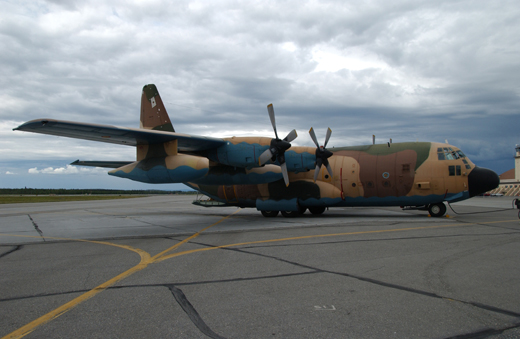 | |
A C-130 Hercules airplane from the Spanish Air Force parks on the flightline for their stay during Red Flag-Alaska 07-3 at Eielson Air Force Base. |
On 13 May 2005, The Department of Defense proposed a major realignment of the base as part of the Base Realignment and Closure program.
- It was decided that Eielson Air Force Base was to remain open.
- That the 354th Wing's A-10 Thunderbolt II aircraft were to be redistributed to the Air Force Reserve Command's 917th Wing at Barksdale Air Force Base, Louisiana (three aircraft); to the Air Combat Command's 23d Wing at Moody Air Force Base, Georgia (12 aircraft); and to backup inventory at AMARC at Davis-Monthan Air Force Base, Arizona (three aircraft). This action was part of a larger effort to consolidate the A-10 fleet. The 355th Fighter Squadron (355 FS) was inactivated on 15 August 2007 when the last A-10 departed Eielson.
- The 18th Fighter Squadron (18 FS) converted to the 18th Aggressor Squadron. This squadron trains in the same manner as the aggressors at Nellis AFB, learning the flying styles and abilities of foreign air forces to train USAF pilots. Aircraft changes entail sending all 18 of its Block 40 F-16 Fighting Falcons to Kunsan Air Base, Korea, and receiving 18 Block 30 F-16Cs from Kunsan. The 18 Aggressor Squadron was officially established on 24 August 2007.
- The Alaska Air National Guard's 168th Air Refueling Wing and its KC-135 Stratotanker aircraft will remain at Eielson.
The above content comes from Wikipedia and is published under free licenses – click here to read more.
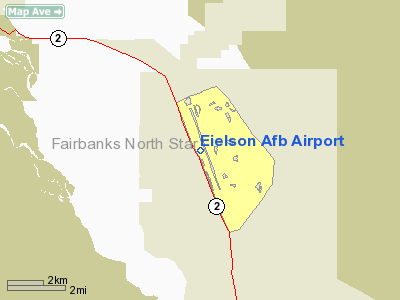
Location & QuickFacts
|
FAA
Information Effective: |
2006-02-16 |
|
Airport Identifier: |
EIL |
|
Longitude/Latitude: |
147-06-05.4000W/64-39-56.4000N
-147.101500/64.665667 (Estimated) |
|
Elevation: |
548
ft / 167.03 m (Estimated) |
|
Land: |
0
acres |
|
From nearest
city: |
17
nautical miles SE of Fairbanks, AK |
|
Location: |
Fairbanks
County, AK |
|
Magnetic
Variation: |
27E
(1995) |
Owner & Manager
|
Ownership: |
Air Force
owned |
|
Owner: |
U S Govt
Usaf |
|
Address: |
5010 Csgp
Eielson Afb, AK 99702 |
|
Manager: |
Chief Airfield
Management |
|
Address: |
343 Csg/otm
Eielson Afb, AK 99702 |
|
Phone number: |
907-377-3201 |
Airport Operations
and Facilities
|
Airport
Use: |
Private |
|
Wind indicator: |
Yes |
|
Segmented
Circle: |
No |
|
Control Tower: |
Yes |
|
Attendance
Schedule: |
ALL/ALL/ALL |
|
Lighting
Schedule: |
DUSK-DAWN |
|
Beacon Color: |
Clear-Green
(lighted land airport) |
|
Sectional
chart: |
Fairbanks |
|
Region: |
AAL
- Alaska |
|
Boundary
ARTCC: |
ZAN
- Anchorage |
|
Tie-in FSS: |
EIL
- Eielson |
|
FSS on Airport: |
No
PPR RQRD OR EMERG. |
|
FSS Toll
Free: |
LC474-0137 |
|
NOTAMs Facility: |
PAEI
(NOTAM-d service avaliable) |
Airport Services
|
Airframe
Repair: |
NONE |
|
Power
Plant Repair: |
NONE |
|
Bottled Oxygen: |
NONE |
|
Bulk Oxygen: |
NONE |
|
Runway Information
Runway 13/31
|
Dimension: |
14507 x 150 ft
/ 4421.7 x 45.7 m |
|
Surface: |
CONC,
|
|
Surface Treatment: |
Saw-cut
or plastic Grooved |
|
Weight Limit: |
Single wheel: 65000 lbs. |
|
Edge Lights: |
High |
|
|
Runway 13 |
Runway 31 |
|
Elevation: |
537.00 ft |
547.00 ft |
|
ILS Type: |
LOC/GS |
ILS |
|
Traffic Pattern: |
Right |
Left |
|
Markings: |
Precision instrument, Good Condition |
Precision instrument, Good Condition |
|
Arresting: |
BAK12 |
BAK12 |
|
Crossing
Height: |
48.00 ft |
49.00 ft |
|
VASI: |
4-light PAPI on left side |
4-light PAPI on left side |
|
Visual Glide
Angle: |
2.70� |
2.70� |
|
RVR Equipment: |
touchdown |
touchdown |
|
Approach
lights: |
NON STD 2 PARALLEL ROW APCH LGTS-AF TYPE E. |
ALSAF
RY APCH LIGHTS ON WHEN TWR CLSD. |
|
Runway End
Identifier: |
No |
No |
|
Centerline
Lights: |
No |
No |
|
Touchdown
Lights: |
No |
No |
|
Radio Navigation
Aids
|
ID |
Type |
Name |
Ch |
Freq |
Var |
Dist |
|
CUN |
NDB |
Chena |
|
257.00 |
28E |
14.5
nm |
|
FOX |
NDB |
Fox |
|
356.00 |
28E |
22.0
nm |
|
EIL |
TACAN |
Eielson |
098X |
|
26E |
0.7
nm |
|
FAI |
VORTAC |
Fairbanks |
023X |
108.60 |
28E |
24.7
nm |
Remarks
- TRANS
ALERT SVC AVBL 0700-0000 MON-FRI EXCP HOL; OTHER TIMES PPR THROUGH
BASOPS.
- DEP
ACFT REMAIN AT OR BLO 1500 FT TIL DEP END OF RY.
- ALL
PACAF FTR ACFT ON ARR EXPECT REDUCED RY SEPARATION; SIMILAR FTR TYPE/DAY
- 3000 FT; DISSIMILAR FTR TYPE AND/OR NGT WET RY OR RCR RPT LESS THAN
17 - 6000 FT; BEHIND FORMATION LNDG - 6000 FT; FTR TYPE LDG BEHIND
NON-FTR TYPE - 9000 FT; RCR VALIDATED AS CONDITIONS WARRANT.
- FLIGHTS
ORIGINATING OUTSIDE OF THE STATE REFER TO ALASKA SECTION OF US AIR
FORCE - FOREIGN CLEARANCE GUIDE.
- PRACTICE
APCHS BY TRANSIENT ACFT DURING LCL FLYING APR-OCT REQUIRE 354 FW/SOF
APPROVAL.
- LTD
FLEET SVC AVBL; NO POTABLE WATER. TRANS BILLETING EXTREMELY LTD/EXTENSIVE
FUEL DELAYS POSSIBLE DUR COPE THUNDER EXCERCISE (APR-OCT).
- ARCTIC
GEAR IS STRONGLY ENCOURAGED DUE TO POSSIBLE EXTREME COLD TEMPERATURES
1 OCT - 31 MAR; LTD SUPPLIES ON HAND.
- QUIET
HRS 0700-1600Z++ EXCP RQR OG/CC APVL.
- MAINT
SUPPORT LIMITED 1800-0800 MON-FRI; OTR TIMES WITH PRIOR COORDINATION.
- AIR
TERMINAL AND GROUND HANDLING SVC OPRS 1630-0030Z++ WEEKDAYS. ACFT
REQUIRING TERMINAL AND GROUND HANDLING SVC ARE REQUIRED TO PROVIDE
ADVANCE NOTICE OR DELAYS IN SVC MAY BE EXPERIENCED. ACFT REQUIRING
SVC SHOULD MAKE PRIOR COORDINATION WITH HQ AMC TACC AND BASOPS.
- ALASKA
ANG 168TH AREFS OPS DSN 317-377-8800.C 907-377-8800) ANG OPR 24 HRS.
- FOR
FLT ADVISORIES OR STATUS OF RESTRICTED & MOAS CTC EIELSON RANGE
CTL ON SAUIS RADIO 125.3 OR CALL 1-800-758-8723.
- 30
MIN PRIOR NOTICE REQUIRED FOR LANDING/TAKEOFF WHEN ATCT CLSD.
- FOR
PPR NUMBER CALL DSN 317-377-1861 C907-377-1861.
- TWY
'F' BTN TWY 'C' & TWY 'D' CLSD TO B-1 ACFT.
- RY
13 & 31 PAPI GS NOT COINCIDENTAL WITH ILS GS.
- RSTD:
T-TAIL DEICING OF C-5 AND C-17 NOT AVAILABLE FROM TRANSIENT ALERT.
- CRYPTO
MATERIALS NOT AVBL TRAN CREW. ALL ACFT WITH VIP CTC BASOPS 20-30 MINUTES
PRIOR TO ETA WITH FIRM CHOCK TIME.
- PPR
NUMBER REQUIRED PRIOR TO FILING AND EXPECT ARRIVAL TIME RESTRICTION
FOR ALL ACFT, EXCEP AIREVAC & DV CODE 7 OR HIGHER.
- DURING
BIRD WATCH CONDITION MOD LCL PATTERN WORK LIMITED TO MIN RQR WITH/OG/CC
APPROVAL, NO TGL, FORMATION TKOF, LNDG PROHIBITED AND LOW APCH LIMITED
TO 300 FT AGL. DURING BIRD WATCH CONDITION SEVERE TKOF, PATTERN, AND
LANDING LNDG PROHIBITED WITHOUT OG/CC APPROVAL EXCEP FOR EMER.
- MOOSE
HAVE BEEN SPOTTED ON OR NEAR THE RY ENVIRONMENT ALL HRS OF THE DAY.
MOOSE MOVEMENT IS PARTICULARLY INTENSE DURING SR-SS.
- N
BARRIER TAPE REDUCED TO 950 FT.
- UNLGTD
BLDGS ALONG NE SIDE OF AIRFIELD APRXLY 1500 FT TO 1700 FT OFF RY CNTRLN.
- USE
OF TWY 'G' RSTRD TO DAYTIME WITH VSBY 1 MILE OR GREATER.
- ALL
TRANSIENT AIRCREWS MUST REGISTER WITH BASE OPS UPON ARRIVAL. SEE AP1
SUPPLEMENTARY ARPT RMKS.
- LIMITED
SECRET STORAGE AVBL AT BASE OPS, FOR TOP SECRET CTC COMMAND POST DSN
317-377-1500.
- PORTIONS
OF THE RAMP NOT VISIBLE FROM ATCT. VEHICLES MAY BE OPERATING IN THIS
AREA.
- ALL
CONTINGENCY OPER CTC AMGR FOR COORDINATION.
- TRAN
ALERT: TRANSIENT MAINT LMTD TO F16 SVCG UPON AIRCREW REQ. THRU FLIGHT/BPO/PREFLIGHT
ISNP OF F16 NOT AVBL. PRE COORD WITH MAIN OPS CENTER DSN 317-1205
NLT 48 HRS FM ETA.
- 354
WG OPS-(IGLOO OPS) (HAVE QUICK 289.4) 259.5
- OVERHEAD
TFC PAT ALT 2000 FT MSL; RECTANGULAR TFC PAT ALT 1500 FT MSL.
- AVOID
SMALL ARMS RANGE LCTD 2.5 NM NE OF AER 31. SMALL ARMS RANGE ACTIVE
WEEKDAYS 0800-1600. OTHER TIMES BY ADVISORY.
- CARGO
& PSGR CARRYING ACFT CALL PTD 30 MIN PRIOR TO LNDG WITH ETA; NUMBER
OF PSGRS/TYPE OF CARGO & SVC REQ UPON LNDG.
- HEAVY
BIRD ACTIVITY DURING MONTHS OF APR/MAY/AUG & SEP. DURING PERIODS
OF STANDING WATER ON THE AIRFIELD, GULLS, DUCKS, GEESE AND OTHER BIRDS
POSE A SIGNIFICANT HAZARD TO ACFT. REPORT ALL BIRD AND ANIMAL STRIKES
ON & INVOF EILSON TO AIRFIELD MANAGEMENT, DSN 317-377-1861, PTD
OR 354FE/SE DSN 317-377
- BASE
OPS DSN 317-377-1861/3201; TO AVOID DELAY FILE FLIGHT PLAN AT LEAST
1 HR PRIOR TO ETD; ARRIVALS REQUIRING CUSTOMS MUST NOTIFY BASE OPS
1.5 HRS PRIOR TO LNDG; US IMMIGRATION SVC NOT AVBL.
Operational
Statistics
|
Aircraft
Operations: |
50/Day |
|
Military: |
100.0% |
Eielson
Afb Airport
Address: Fairbanks
County, AK
Tel:
907-377-3201
Images
and information placed above are from
http://www.airport-data.com/airport/EIL/
We
thank them for the data!
| General
Info |
| Country |
United
States |
| State |
ALASKA
|
| FAA ID |
EIL |
| Latitude |
64-39-56.400N
|
| Longitude |
147-06-05.400W
|
| Elevation |
548 feet
|
| Near City |
FAIRBANKS
|
We don't guarantee the information is fresh and accurate. The data may be wrong or outdated.
For more up-to-date information please refer to other sources.
|
 |



